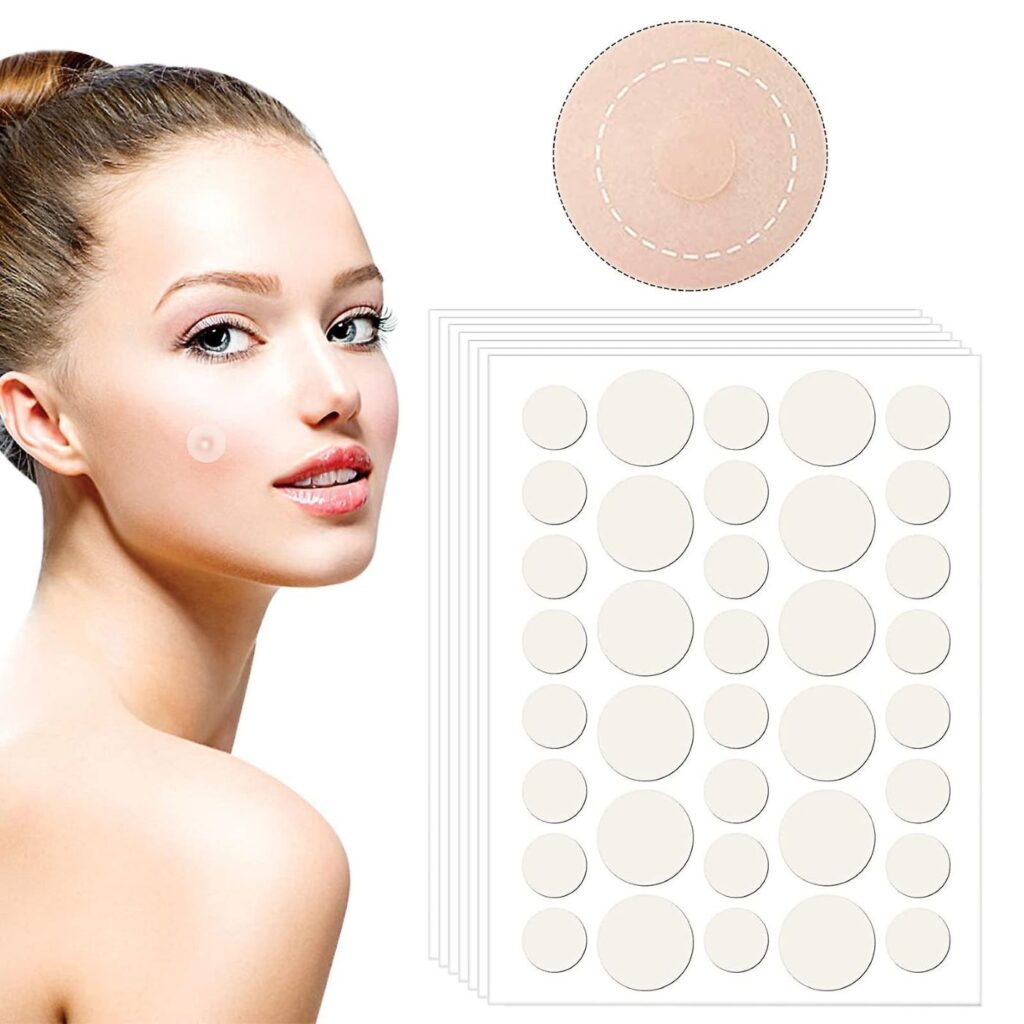Skin Care
Mystery: Why Pimple Patches Turn White
Pimple patches are made of a hydrocolloid material, which is a type of dressing commonly used in wound care. This material has the ability to absorb moisture and create a moist environment.
Pimple patches, also known as acne patches or hydrocolloid patches, have gained popularity in recent years as an effective solution for treating pimples. But how do they actually work? Let’s dive into the science behind these tiny adhesive circles and understand their mechanism of action.
When a pimple patch is applied to a pimple, it creates a barrier that protects the blemish from external irritants and prevents it from further infection.
But that’s not all. The magic of pimple patches lies in their ability to draw out impurities from the pimple. The hydrocolloid material acts like a sponge, absorbing excess sebum, dead skin cells, and bacteria. As the patch absorbs these impurities, it starts to swell and turn white, indicating that it is actively working to heal your pimple.
So, in essence, pimple patches work by creating an ideal healing environment for your pimples while simultaneously absorbing impurities and promoting faster healing. Now that we understand the basics, let’s explore why these patches turn white and what it means for your skin.

Why do pimple patches turn white?
If you’ve ever used pimple patches, you’ve probably noticed that they turn white with time. But what exactly causes the color change? The answer is a combination of dead skin cells, oil, and germs that the patch absorbs from the pimple.
When a pimple patch gets into contact with a pimple, it begins to absorb excess sebum, an oily material produced by your skin. This sebum contains dead skin cells and germs, which help to produce pimples. The patch absorbs both sebum and pollutants, resulting in a white appearance.
The white tint indicates that the patch is currently working to repair your pimple. It indicates that the patch has absorbed the pollutants, keeping them from blocking your pores and causing future breakouts. So, seeing a white patch is a good sign that your pimple is being treated properly.
Understanding the science underlying color change can help you determine the efficiency of your pimple patch and verify that you are using it correctly. However, it is crucial to note that the color shift might vary depending on a number of factors, which we shall discuss in the following section.
Understanding the science behind the color change
The color shift in pimple patches is a fascinating and scientifically supported process. It all starts with the hydrocolloid substance, which is the primary component of these patches. This material can absorb moisture and provide a moist environment, which is required for wound healing.
When a pimple patch makes contact with a pimple, it begins to absorb excess sebum, dead skin cells, and germs. As these contaminants are absorbed, the patch experiences a chemical reaction, causing it to enlarge and turn white. This reaction is referred to as gel formation.
During gel development, the hydrocolloid material absorbs water molecules from the pimple, causing it to expand and form a gel-like substance. This gel binds pollutants within its structure, preventing them from spreading and causing more inflammation. As additional pollutants are absorbed, the gel expands, resulting in a more noticeable white color.
It is vital to remember that the color shift does not occur immediately. The patch takes some time to absorb enough contaminants to appear white. The duration varies according on the size and intensity of the pimple, as well as the individual’s skin condition.
Now that we’ve covered the science behind color change, let’s look at the factors that influence the strength of the white color in pimple patches.

Factors that affect the color change in pimple patches
While pimple patches typically turn white when they absorb pollutants, the degree of the white color varies depending on a number of circumstances. Understanding these aspects might help you interpret color changes and make more informed skincare selections.
- Size and severity of the pimple: Larger and more severe pimples tend to produce more sebum and impurities, resulting in a more intense white color. Smaller pimples may not produce as much sebum, leading to a less noticeable color change.
- Skin condition: The condition of your skin can also affect the color change. If your skin is naturally oily, the pimple patch may turn white more quickly and intensely. On the other hand, if your skin is dry, the color change may be less pronounced.
- Patch material and thickness: Different pimple patches may have varying absorption capacities and thicknesses. Thicker patches may absorb more impurities, leading to a more visible white color. Additionally, the material of the patch can affect its ability to absorb sebum and bacteria.
- Duration of wear: The longer you wear a pimple patch, the more impurities it can absorb. If you leave the patch on overnight or for several hours, you may notice a more significant color change compared to a shorter wear time.
- Individual skin chemistry: Each person’s skin chemistry is unique, and this can influence the color change in pimple patches. Factors such as pH levels, hydration, and bacterial flora on the skin can impact the absorption and coloration process.
While these factors can influence the color change, it’s important to remember that the effectiveness of a pimple patch is not solely determined by the intensity of the white color. The patch’s ability to absorb impurities and create an optimal healing environment is what truly matters.
Now that we have a better understanding of the color change in pimple patches, let’s explore the significance of this phenomenon and how it can help you achieve clearer skin.
The significance of the color change in pimple patches
The color change in pimple patches serves as a visual indicator of their effectiveness and can provide valuable insights into your skin’s condition. Here are a few reasons why the color change is significant:
- Monitoring progress: The white color of a pimple patch indicates that it is actively absorbing impurities and promoting healing. By monitoring the color change over time, you can track the progress of your pimple’s healing process. This can be particularly useful for larger or more stubborn pimples.
- Preventing further breakouts: Pimple patches not only treat existing pimples but also help prevent new breakouts. As the patch absorbs impurities, it prevents them from spreading to surrounding areas and causing inflammation. The visible white color can reassure you that the patch is doing its job in keeping your skin clear.
- Encouraging adherence: The color change can act as a motivator to keep using the pimple patch consistently. Seeing the patch turn white can provide a sense of satisfaction and encourage you to continue using it as part of your skincare routine.
- Learning about your skin: The intensity of the white color can provide insights into your skin’s condition and sebum production. If you consistently notice a strong color change, it may indicate that your skin produces more sebum and is prone to breakouts. This knowledge can help you tailor your skincare routine accordingly.
Now that we’ve explored the significance of the color change, let’s delve into some practical tips on how to use pimple patches effectively.

How to use pimple patches effectively
To maximize the effectiveness of pimple patches, it’s important to follow a few simple guidelines:
- Start with clean, dry skin: Before applying a pimple patch, cleanse your skin to remove any dirt, oil, or makeup. Ensure that the area is completely dry before applying the patch.
- Choose the right size: Pimple patches come in various sizes to accommodate different pimple sizes. Select a patch that fully covers the pimple and provides a tight seal around the edges.
- Apply gently: Carefully peel the patch from its backing and apply it directly onto the pimple. Press down gently to ensure good adhesion.
- Leave it on for the recommended time: Most pimple patches are designed to be left on for several hours or overnight. Follow the instructions provided by the manufacturer to achieve optimal results.
- Replace when necessary: Pimple patches can become saturated with impurities over time. If you notice that the patch has turned completely white or has lost its adhesion, it’s time to replace it with a fresh one.
By following these simple steps, you can ensure that you are using pimple patches effectively and maximizing their benefits. Now, let’s explore some additional benefits of using pimple patches in your skincare routine.
Other benefits of using pimple patches
While the primary purpose of pimple patches is to treat pimples, they offer several additional benefits that can enhance your skincare routine:
- Protection from external irritants: Pimple patches create a barrier that protects your pimples from external irritants such as dirt, bacteria, and makeup. This helps prevent further infection and inflammation, allowing your pimple to heal faster.
- Reduced scarring: By keeping the pimple covered and protected, pimple patches can help minimize the risk of scarring. They prevent you from picking or popping the pimple, which can lead to scarring and post-inflammatory hyperpigmentation.
- Invisible and discreet: Many pimple patches are thin and transparent, making them virtually invisible when applied to the skin. This means you can wear them during the day without drawing attention to your pimples.
- Non-drying: Unlike some acne treatments that can dry out the skin, pimple patches help maintain the skin’s moisture balance. They create a moist environment that promotes healing without stripping the skin of its natural oils.
These additional benefits make pimple patches a versatile and convenient solution for tackling pimples and maintaining clear skin. However, it’s important to address some common misconceptions about pimple patches and the color change.
Conclusion
Pimple patches have changed how we treat pimples by creating a healing environment and absorbing contaminants. The patch’s white color serves as visual evidence of its success, demonstrating that it is actively working to heal the pimple.
Understanding the science behind color change and the factors that influence it will help you determine the success of your pimple patch and ensure that it is being utilized correctly. Following the specified regulations and including pimple patches into your skincare routine can help you achieve cleaner skin and prevent future breakouts.
Remember that pimple patches are not a cure-all for acne, but they can be an effective tool in your arsenal for maintaining healthy, blemish-free skin. So, the next time you apply a pimple patch and it becomes white, you’ll know you’ve made progress towards improved skin.
Trusted Health, Wellness, and Medical advice for your well-being



